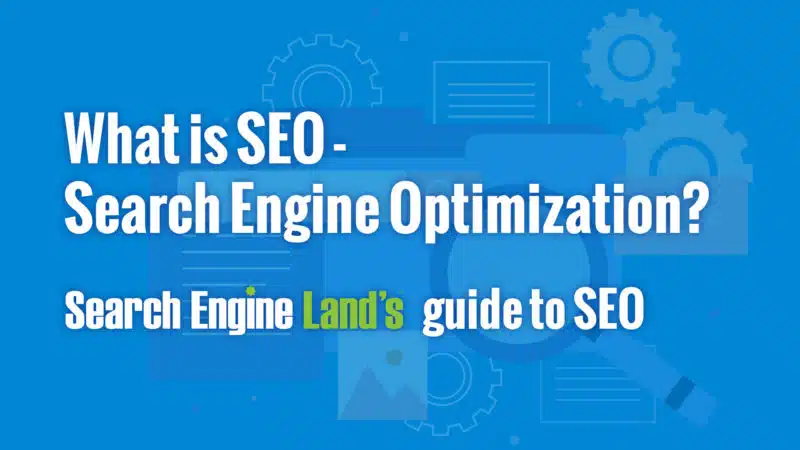
SEO stands for “search engine optimization.” In simple terms, SEO means the process of improving your website to increase its visibility in Google, Microsoft Bing, and other search engines whenever people search for:
- Products you sell.
- Services you provide.
- Information on topics in which you have deep expertise and/or experience.
The better visibility your pages have in search results, the more likely you are to be found and clicked on. Ultimately, the goal of search engine optimization is to help attract website visitors who will become customers, clients or an audience that keeps coming back.
What you’ll learn in this guide:
- How SEO differs from SEM and PPC
- Why SEO is important
- SEO types and specializations
- How SEO works
- How to learn SEO
How is SEO different from SEM and PPC?
SEM and PPC are two other common terms you will read about a lot here on Search Engine Land and hear about in the larger search marketing community.
Read on to learn more about both of these terms and how they’re related to SEO.
SEO vs. SEM
SEM stands for search engine marketing – or, as it is more commonly known, search marketing.
Search marketing is a type of digital marketing. It is an umbrella term for the combination of SEO and PPC activities meant to drive traffic via organic search and paid search.
Put simply, search marketing is the process of gaining traffic and visibility from search engines through both paid and unpaid efforts.
So how do SEO and SEM differ? Technically they aren’t different – SEO is simply one-half of SEM:
- SEO = driving organic traffic from search engines.
- SEM = driving organic and paid traffic from search engines.
Now, this is where things get a bit confusing.
Today, many people use SEM interchangeably with PPC (which we’ll talk about in the next section).
This idea seems to undercut SEO. However, SEO is marketing, just like PPC is marketing.
Here’s the best way to think about SEO and SEM:
Imagine SEM is a coin. SEO is one side of that coin. PPC is on the flip side.
SEO vs. PPC
PPC stands for pay-per-click – a type of digital marketing where advertisers are charged whenever one of their ads gets clicked on.
Basically, advertisers bid on specific keywords or phrases that they want their ads to appear for in the search engine results. When a user searches for one of those keywords or phrases, the advertiser’s ad will appear among the top results.
So again, if we think of search marketing as a coin, SEO and PPC are two sides of the same coin – SEO is the unpaid side, PPC is the paid side.
Another key point: it’s important never to think of it as “SEO vs. PPC” (i.e., which one is better) because these are complementary channels. It’s not an either-or question – always choose both (as long as your budget allows it).
As we mentioned before, the terms SEM and PPC are used within the industry interchangeably. However, that isn’t the case here on Search Engine Land.
Whenever we mention “SEM,” it will be because we’re referring to both SEO (organic search) and PPC (paid search).
If you’re curious about the history behind how “SEM” came to mean “PPC” at the exclusion of SEO, you can dig deeper into these articles:
Types of SEO
There are three types of SEO:
- Technical SEO: Optimizing the technical aspects of a website.
- On-site SEO: Optimizing the content on a website for users and search engines.
- Off-site SEO: Creating brand assets (e.g., people, marks, values, vision, slogans, catchphrases, colors) and doing things that will ultimately enhance brand awareness and recognition (i.e., demonstrating and growing its expertise, authority and trustworthiness) and demand generation.
You maintain 100% control over content and technical optimizations. That’s not always true with off-site (you can’t control links from other sites or if platforms you rely on end up shutting down or making a major change), but those activities are still a key part of this SEO trinity of success.
Imagine SEO as a sports team. You need both a strong offense and defense to win – and you need fans (a.k.a., an audience). Think of technical optimization as your defense, content optimization as your offense, and off-site optimization as ways to attract, engage and retain a loyal fanbase.
Technical optimization
Optimizing the technical elements of a website is crucial and fundamental for SEO success.
It all starts with architecture – creating a website that can be crawled and indexed by search engines. As Gary Illyes, Google’s trends analyst, once put it in a Reddit AMA: “MAKE THAT DAMN SITE CRAWLABLE.”
You want to make it easy for search engines to discover and access all of the content on your pages (i.e., text, images, videos). What technical elements matter here: URL structure, navigation, internal linking, and more.
Experience is also a critical element of technical optimization. Search engines stress the importance of pages that load quickly and provide a good user experience. Elements such as Core Web Vitals, mobile-friendliness and usability, HTTPS, and avoiding intrusive interstitials all matter in technical SEO.
Another area of technical optimization is structured data (a.k.a., schema). Adding this code to your website can help search engines better understand your content and enhance your appearance in the search results.
Plus, web hosting services, CMS (content management system) and site security all play a role in SEO.
Content optimization
In SEO, your content needs to be optimized for two primary audiences: people and search engines. What this means is that you optimize the content your audience will see (what’s actually on the page) as well as what search engines will see (the code).
The goal, always, is to publish helpful, high-quality content. You can do this through a combination of understanding your audience’s wants and needs, data and guidance provided by Google.
When optimizing content for people, you should make sure it:
- Covers relevant topics with which you have experience or expertise.
- Includes keywords people would use to find the content.
- Is unique or original.
- Is well-written and free of grammatical and spelling errors.
- Is up to date, containing accurate information.
- Includes multimedia (e.g., images, videos).
- Is better than your SERP competitors.
- Is readable – structured to make it easy for people to understand the information you’re sharing (think: subheadings, paragraph length, use bolding/italics, ordered/unordered lists, reading level, etc.).
For search engines, some key content elements to optimize for are:
- Title tags
- Meta description
- Header tags (H1-H6)
- Image alt text
- Open graph and Twitter Cards metadata
Off-site optimization
There are several activities that may not be “SEO” in the strictest sense, but nonetheless can align with and help contribute indirectly to SEO success.
Link building (the process of acquiring links to a website) is the activity most associated with off-site SEO. There can be great benefits (e.g., rankings, traffic) from getting a diverse number of links pointing at your website from relevant, authoritative, trusted websites. Link quality beats link quantity – and a large quantity of quality links is the goal.
And how do you get those links? There are a variety of website promotion methods that synergize with SEO efforts. These include:
- Brand building and brand marketing: Techniques designed to boost recognition and reputation.
- PR: Public relations techniques designed to earn editorially-given links.
- Content marketing: Some popular forms include creating videos, ebooks, research studies, podcasts (or being a guest on other podcasts) and guest posting (or guest blogging).
- Social media marketing and optimization: Claim your brand’s handle on any and all relevant platforms, optimize it fully and share relevant content.
- Listing management: Claiming, verifying and optimizing the information on any platforms where information about your company or website may be listed and found by searchers (e.g., directories, review sites, wikis).
- Ratings and reviews: Getting them, monitoring them and responding to them.
Generally, when talking about off-site, you’re talking about activities that are not going to directly impact your ability to rank from a purely technical standpoint.
However, again, everything your brand does matters. You want your brand to be found anywhere people may search for you. As such, some people have tried to rebrand “search engine optimization” to actually mean “search experience optimization” or “search everywhere optimization

.jpeg)


.jpeg)

0 Comments